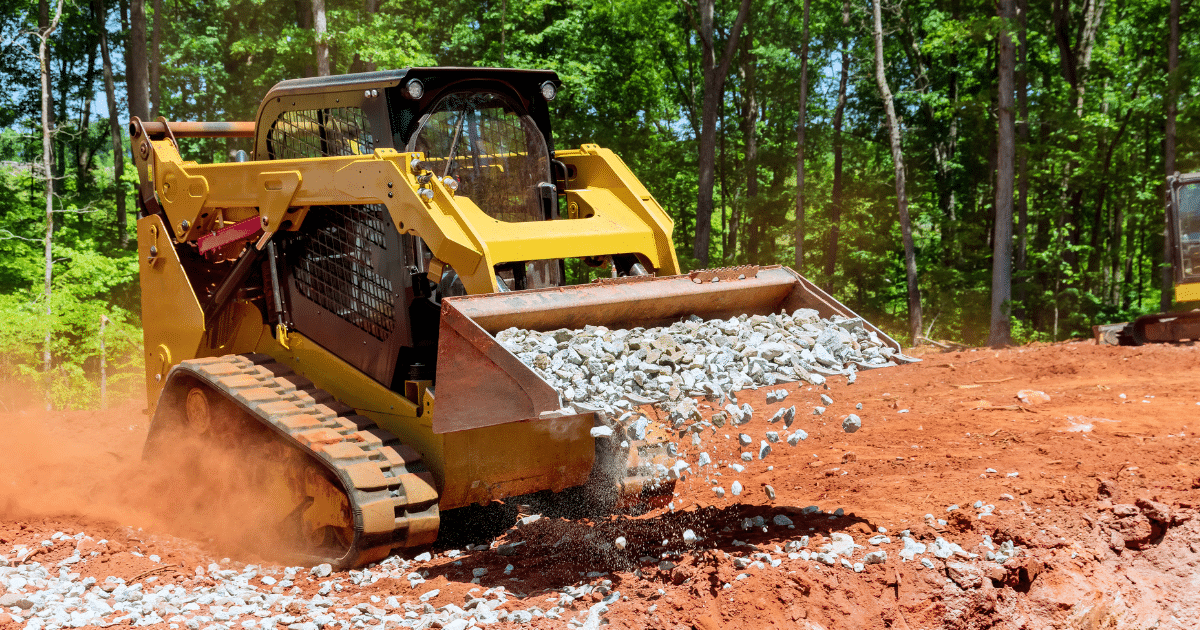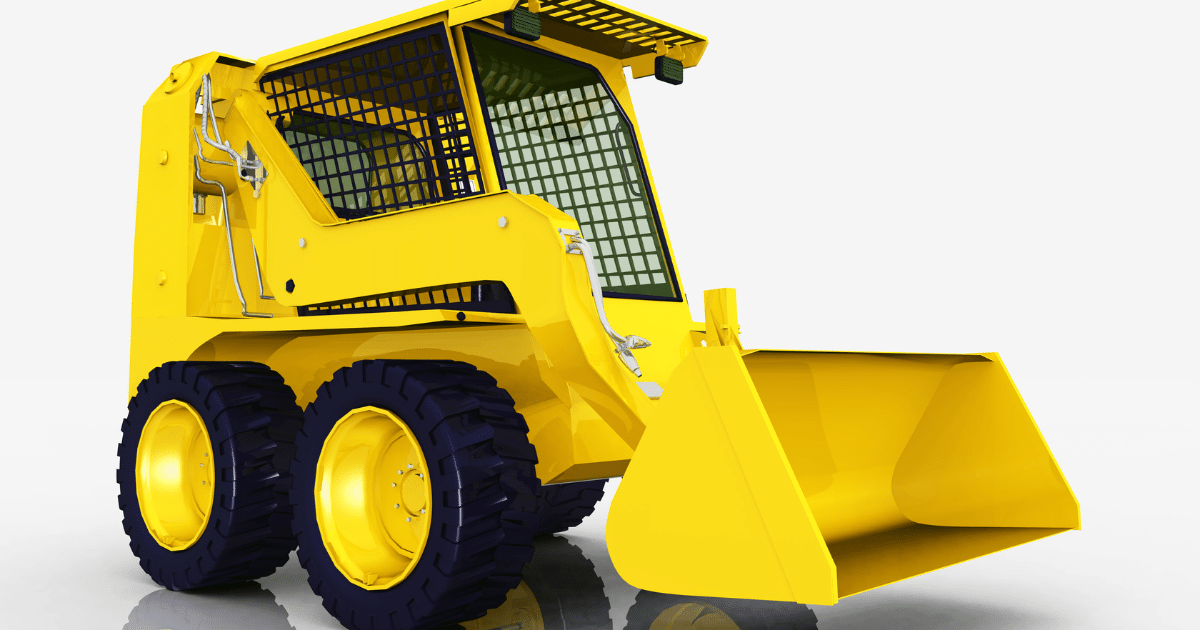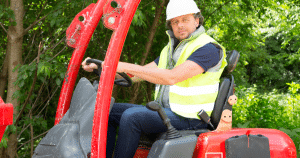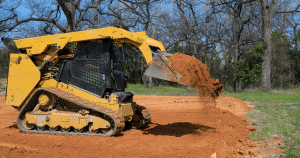Skid steers can lift up to 3,450 pounds. Because of this, they’re a top pick for many jobs. This includes work in construction, landscaping, and industrial areas. Still, some folks worry when thinking about renting one. So, we’re here to answer your top questions on skid steer rentals. Let’s help you understand what you need for your next project.
What is a Skid Steer?
A skid steer is a small but powerful construction machine. It has a lifting arm. These machines are great for using different tools and working in small areas. They can have wheels or tracks and different types of lifting arms.
There are three types of skid steer loaders. They are sized by how much weight they can lift and their engine power. Small skid steers can lift less than 1,750 pounds with engines under 50 HP. Medium models can lift 1,750 to 2,200 pounds with 50-70 HP engines. Large ones can lift over 2,200 pounds and have engines over 70 HP.
Choosing the right skid steer depends on the job’s needs. For flat surfaces, choose wheeled skid steers. They can move quickly. For rough or soft ground, pick tracked models. They are more stable. Track loaders work well on slippery or hilly sites.
Skid steers can do many jobs. They’re good for smoothing land, breaking down small buildings, and clearing snow. They’re also used for digging and moving things. Their size and flexibility make them perfect for building, gardening, and farming.
When choosing a skid steer, think about the work area’s size and condition. Also, consider what you need it to do and the kind of materials it will handle. Renting one could save you money, but also consider the renting considerations offered by the servicing company. This way, companies can use the newest equipment without big investments.
What are the common issues about skid steers?
Skid steers can face several problems just like any heavy machinery. Engine issues, hydraulic problems, and low transmission fluid are the most common. It’s vital to keep up with maintenance and check your skid steer often to avoid these problems. This way, your skid steer will run smoothly when you need it.
Engine Issues
Engine trouble can lead to overheating, guzzling more fuel, or being hard to start. To avoid these, keep the engine’s cooling system in good shape. This means checking the coolant and cleaning the radiator. Don’t forget regular tune-ups and oil changes to keep the engine in top form.
Hydraulic Issues
If you notice the hydraulic system is losing pressure or moving slowly, it may need attention. Checking fluid levels, changing filters, and fixing leaks are important. They ensure your skid steer’s hydraulics work smoothly. Regular maintenance is key to prevent bigger issues.
Low Transmission Fluid Levels
Running out of transmission fluid can cause shifting problems and damage. Make sure to check the fluid often and add more as required. This simple step keeps your skid steer’s transmission in great shape.
A strict maintenance plan is the best way to care for your skid steer. It can extend its life and avoid repair costs. Make sure to do daily, weekly, and monthly checks. Inspect parts, clean, check fluid levels, and complete any necessary fixes. Don’t forget to grease the necessary parts and keep the safety features in check.
Managing these common issues and keeping up with maintenance is key to a well-working skid steer. This way, it won’t let you down when you’re working hard.
How much can a skid steer lift?
When you’re renting a skid steer, it’s vital to know how much it can lift. This depends on its model and size. You must know this to pick the best skid steer for your work.
Smaller skid steers can lift up to 1,750 pounds. Medium ones handle between 1,750 to 2,200 pounds. And large skid steers can lift over 2,200 pounds.
The materials you’re moving also play a part. Sand, gravel, concrete, or fill require bigger skid steers. This means they need more lifting power.
| Skid Steer Size | Rated Operating Capacity |
| Smaller Skid Steers | Up to 1,750 pounds |
| Medium-Sized Skid Steers | 1,750 to 2,200 pounds |
| Larger Skid Steers | Over 2,200 pounds |
Knowing a skid steer’s lifting ability helps you choose the best one. This makes moving materials safe and efficient. It also means you get the most out of your rental.
What is the difference between a skid steer and a bobcat?
Many think “skid steer” and “Bobcat” are the same, but they’re not. Bobcat is a brand within the skid steer loader category. Skid steers are made by Bobcat, Caterpillar, John Deere, and more.
A Bobcat is known as a specific skid steer loader brand. Whereas a skid steer represents all types of this equipment. Beyond Bobcat, other companies make reliable skid steer loaders too.
Skid steers usually have four wheels, ideal for bumpy ground. Their load capacity ranges from 363 kg (800 lbs) to over 1814 kg (two tons). This makes them useful for many jobs. Top skid steer maker brands are Caterpillar, CASE Construction, Komatsu, and Terex.
Skid steers are crucial in construction, landscaping, and more, doing tasks like digging, building, and clearing snow. Renting a Bobcat skid steer might be smarter than buying, especially for occasional use.
The key feature of skid steers is how they can turn in a very small space. This is thanks to having a motor on each wheel. They can use many tools like blades for snow, drills, mowers, and more.
To wrap it up, Bobcat is a type of skid steer loader, not the entire category. Knowing this difference is important when choosing the best equipment for your projects.
How much does a skid steer cost?
Renting a skid steer doesn’t have a fixed price. You will pay based on the model, size, and rental time. Bigger, more powerful skid steers usually cost more. Smaller ones are often cheaper.
Prices are set for days, weeks, or months, giving you options. For wheeled skid steers:
- $200 to $450 is the daily rate.
- Weekly costs range from $750 to $2,000.
- A month might cost you $2,500 to $4,000.
Compact track loaders are a bit more expensive. Here are their average rates:
- $250 to $700 per day.
- Weekly prices are usually $1,000 to $2,000.
- Monthly, you can expect to pay $3,000 to $5,000.
Skid steer rental costs are affected by where and when you rent. During busy times, like construction season, prices can go up. But, choosing a trusted company could save you money on your project.To avoid overpaying, learn the skid steer rental rates. Deal with a good rental service. This way, you can stay on budget and meet your project needs.
What are the best attachments for skid steers?
Skid steers are machines that can do many things. You can add different tools to them for different jobs. These tools make skid steers very useful for work like building and landscaping. Let’s look at some great skid steer attachments and how they help skid steers do more.
Buckets
One popular tool is the bucket. There are many sizes and types of buckets for different jobs. They are great for picking up and moving things like dirt, rocks, and trash.
Augers
Augers dig holes very quickly, which is perfect for putting up fences or gardening. You can pick from many sizes to fit the hole you need.
Grapples and Claws
Grapple buckets and claw tools are for lifting and moving big or heavy items. They have strong arms that hold things tightly as you move them.
Dozer Blades
Dozer blades can push stuff, spread materials, or level the ground. You can move them four ways or six ways to do even more jobs.
Stump Removal
For taking out tree stumps, use a stump bucket. It grabs hold of the stump so you can pull it out easily.
Landscaping Tools
Skid steers can also have tools for working on the land. For example, there are tools for cutting bushes, breaking up soil, and smoothing the ground. These tools help keep the outdoors looking nice.
There are so many different skid steer attachments to choose from. This is why skid steers are great for all sorts of jobs. Pick the right tools, and your skid steer can do a lot more at work.
| Attachment Type | Key Features | Common Applications |
| Bucket | Scooping, loading, and moving materials | Soil, gravel, debris |
| Auger | Efficient hole digging up to 72 inches deep | Fencing, gardening |
| Grapple/Claw | Grabbing, lifting, and transporting heavy/bulky objects | Rocks, logs, debris |
| Dozer Blade | Pushing, spreading, and leveling materials | Soil, gravel, landscaping |
| Stump Bucket | Gripping and extracting stubborn stumps | Land clearing |
| Landscaping Tools | Mowing, aerating, and leveling outdoor spaces | Brush cutting, tilling, raking |
What skid steer size do I need?
Choosing the right skid steer size for your project is very important. Skid steers come in different sizes, each with its own benefits and limits. By knowing about various skid steer sizes, you can pick the best one for your job.
Skid steers are usually divided into small, medium, and large categories. The size you pick depends on the project’s needs, like space availability and material movement. It also depends on how much lifting the job requires.
Small Skid Steers
- Maximum rated operating capacity of 1,750 pounds
- Engines under 50 horsepower
- Ideal for tight spaces and small-scale projects
- Common applications include landscaping, site development, and final grading
Medium Skid Steers
- Rated operating capacity between 1,750 and 2,200 pounds
- Engines ranging from 50 to 70 horsepower
- The most popular size for a wide range of applications
- Suitable for tasks such as material handling, demolition, and light construction
Large Skid Steers
- Minimum rated operating capacity of 2,200 pounds
- Engines with more than 70 horsepower
- Ideal for large-scale projects with no size restrictions
- Commonly used in heavy construction, demolition, and industrial applications
It’s key to think about your project’s specific needs when choosing the skid steer size. Consider the job site conditions, material weight, and your budget. Choosing the right skid steer ensures your job is done well and safely.
Conclusion
Renting a skid steer is smart for your building or yard work. You should know the types of skid steers and what they can do. Madco Rentals in Phoenix, Arizona, is top-notch for equipment rental. We’ll help you pick the best skid steer for your work, making sure your project goes smoothly. For more info on skid steer rental choices and how we back your work, get in touch with us.
Trust Madco Rentals for our dependable service, we’re the go-to for skid steer rentals in Phoenix. We can give you the equipment that works hard for your success!





